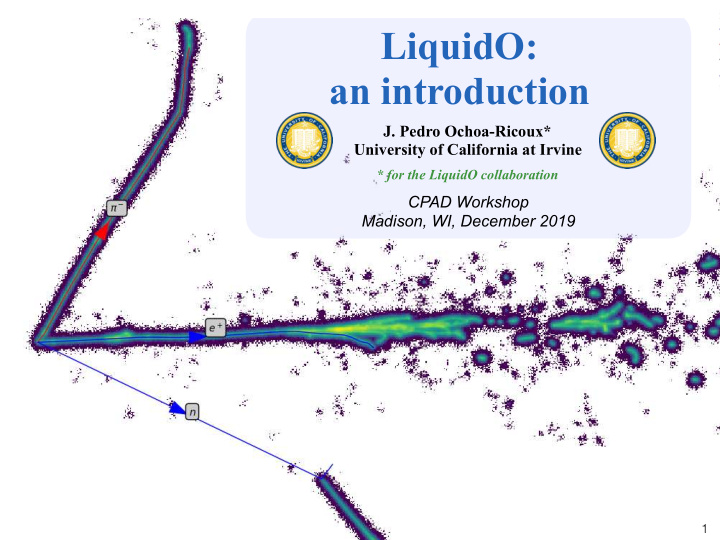



LiquidO: an introduction J. Pedro Ochoa-Ricoux* University of California at Irvine * for the LiquidO collaboration CPAD Workshop Madison, WI, December 2019 1
A new approach! − Liquid Scintillator (LS) detectors have been a workhorse in neutrino physics • Conventional strategy: propagate light through the scintillator to surrounding photosensors − LiquidO is a departure from the conventional paradigm with two main features : 1) Use of an opaque scintillator Main purpose : stochastically confine light near its creation point , to preserve the precious topological information of particle interactions A new and completely counter- intuitive approach! The right opaque scintillator for LiquidO: short scattering length and moderate absorption length More like milk than like dark beer! 2
A new approach! 2) Light collection with a dense fiber array running in at least one direction Main purpose : collect light near its creation point Archetypical LiquidO detector SiPMs are a great choice to readout the fibers (low background, high efficiency, ~0.1 ns time resolution) − LiquidO relies on well-understood, commercially available and relatively inexpensive technology! 3
Imaging down to the MeV scale! − Result: unprecedented imaging capabilities Positron Geant4 simulation of 1 MeV positron in a LiquidO detector with fibers running along z direction with a 1 cm pitch. The scintillator has a 5 mm scattering length. Each pixel corresponds to a fiber. The color scale shows all true hits per fiber A self-segmenting detector! (no need to introduce dead material) 4
LiquidO’s power − Can distinguish ~MeV gammas, electrons and positrons on an individual basis unprecedented! Can achieve electron separation from gammas with efficiency > 85% and contamination ~10 -3 − Additional major advantages: Positron Unparalleled affinity for loading Essentially impossible to Plenty of room to explore unconventional separate these scintillators (e.g. ultra high light-yield) not three on an event- deemed transparent enough for by-event basis in conventional detectors conventional Liquid Scintillator detectors! (Both events at the top are 2 MeV; simulation details are the same as in previous page) 5
First papers More information about LiquidO can be found in arXiv:1908:02859 and arXiv:1908.03334 ~40 scientists from Europe, Asia and the Americas currently working on LiquidO (see also seminar at CERN: https://indico.cern.ch/event/823865/) 6
Physics Potential • LiquidO’s capabilities open up a realm of possibilities in many areas of neutrino physics. Here I highlight a few: ββ Example Event - Search for neutrinoless double-beta decay (0 νββ ): Key advantages: background control and ability to load well beyond current limits Looks like a very promising path for reaching deep into the normal ordering region! - Solar neutrinos: Sn* decay Expect good performance “as is” Exciting possibility: Indium loading could allow to use the reaction first proposed by Raghavan in 1976 to do pp solar neutrino physics v e + 115 In → 115 Sn * + e − γ + β γ + γ 7
Physics Potential - Supernova neutrinos: JUNO spectra for SN @ 10 kpc (for reference) - Low energy threshold (~0.1 MeV) - Channels not accessible with other detectors - Charge sign ID (e + /e - ) - Directionality information for events ⪆ 10 MeV - Sensitivity to Di ff use Supernova Neutrino Background ν K + p → ¯ Example event - Search for nucleon decay: - Can see *all* channels Michel e + - Largest achievable density of free protons (thanks to scintillator) μ + ( τ 1/2 :2.2 μ s) - Very high-efficiency γ (annihilation) - Full topological information and sign-ID for some channels through final Michel K + ( τ 1/2 :12.4ns) electron - Others (geoneutrinos, reactor LiquidO-preliminary antineutrinos… etc) 8
LiquidO can also do beam physics! − LiquidO would reveal GeV-neutrino interactions in extremely powerful way: LiquidO-preliminary Large event size High duty cycle + (thanks to Low-Z) fast timing Charge sign ID from π - → μ - → e - Rich calorimetric info (>100 kPEs / GeV) (~ μ s scale) Clear track before shower Higher energy gammas (could enable charge sign (and corresponding pair Beautiful tracking ID with magnetic field) production) (2 GeV electron antineutrino; 4 mm fibre pitch and 1 mm scattering length; inefficiencies associated with photon detection are accounted for) Can see neutrons! Halo of gammas from - Measure their energy via TOF!! EM shower and - Capture at the end (~O(10) μ s scale) positron annihilations + Complementary features Imaging capabilities unique to LiquidO comparable to those of LArTPC 9
LiquidO-preliminary A couple more examples @ 2 GeV LiquidO-preliminary LiquidO-preliminary Publications about LiquidO’s physics potential are in preparation! 10
Does it work? - A first-principles validation of LiquidO has already been accomplished in the laboratory: Observed stochastic confinement of the light with the opaque sample! (see arXiv:1908.02859 for more details) 11
Status of R&D - R&D well advanced in terms of detector, mechanics, optical readout & scintillator: - We are about to commission a 7.5 liter prototype called “Mini-LiquidO” - In parallel, working towards a multi-ton demonstrator detector 12
Summary & Conclusions − LiquidO is an innovative neutrino detection technology that exploits the power in opaque scintillators for the first time − LiquidO builds on successes of mainstream scintillator detectors but brings unprecedented capabilities to the table. For instance: - Beautiful imaging from the GeV scale down to the MeV scale - Unparalleled doping ability − LiquidO could have a very strong impact in many areas of neutrino physics: - The parameter space is very wide, and LiquidO can be optimized for many different energies and physics goals - Plenty of uncharted territory to explore (unprecedented doping levels, unconventional scintillators… etc) − LiquidO still in early stages, but R&D progressing rapidly and steadily: - Proof-of-principle already obtained, and working towards a multi-ton demonstrator We have only scratched the surface so far… stay tuned!! 13
Recommend
More recommend